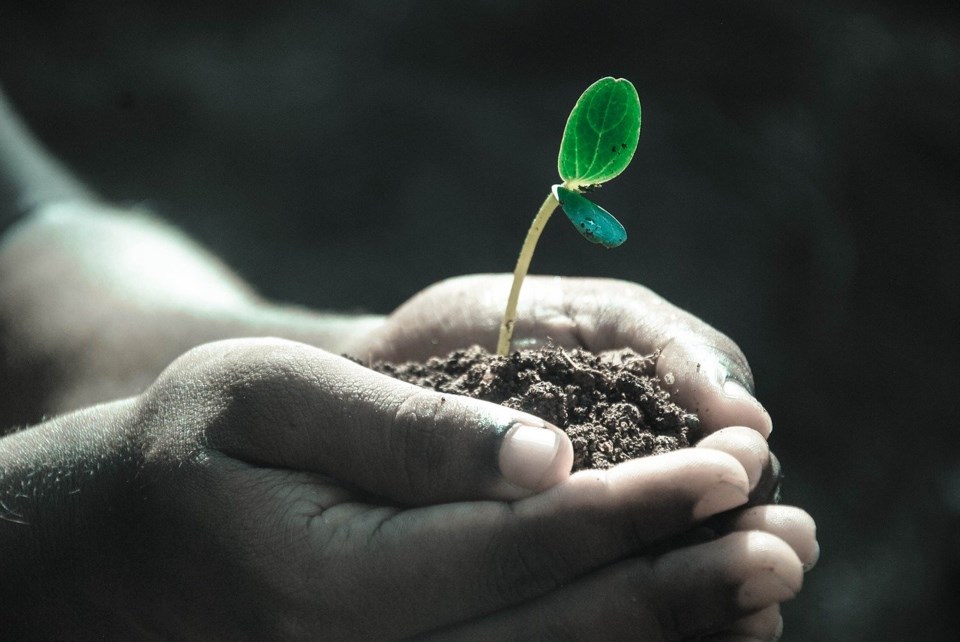Despite writing an article each on healthy soils and water quality a few years ago, I still did not realize that the answer to climate change is soil regeneration.
A friend recently recommended the 2019 documentary The Need to Grow by Earth Conscious Films.
According to the film, we have roughly 60 years of farmable soil left on the planet, mostly due to unsustainable agriculture. In the last 40 years, Earth has lost a third of its arable soil and the U.S. is losing its soil at 10 times the rate required to regenerate it.
Moreover, industrial agriculture — the invention of powerful chemicals and machinery — costs the environment three trillion a year. (FYI, after the Second World War, there was an excess of bomb-making material, which was turned into fertilizer, and excess of nerve gas, which was turned into pesticides. So the military industrial complex moved into the agricultural industrial complex, and forced a model of chemical dependency.)
Agriculture is the most destructive human activity on the planet.
Since its dawn some 10,000 years ago, the simple act of tilling the land destroys soil life (a handful of healthy soil contains more micro-organisms than there are people on the planet), its ability to hold water, and turning soil carbon into atmospheric carbon dioxide. By killing the biology (life) within soils, we are literally taking a step back in hundreds of millions of years.
Moreover, everything we do on land affects our oceans. Up to 50% of nitrogen fertilizers are washed away with rain and irrigation water. For the U.S., this results in an ocean “dead zone” the size of New Jersey.
Industrial agriculture has exponentially exacerbated the impacts, leading to more frequent drought, serious food scarcity and ultimately, climate change. Roughly 30 soccer fields worth of soil are lost every single minute. To date, approximately 70% of the Earth’s soils have already been destroyed. Without soil, all ecosystems outside our oceans become impossible.
The entire food chain — our very existence — is made possible by billions of tiny creatures co-existing in a vast galaxy-like network under our very feet.
“We can send a man to the moon but we have no idea what’s happening with those billion microbes,” says Erik Cutter, micro-farm master and founder of Alegria Farms.
You may have heard arguments in support of industrial agriculture — i.e., there are efficiencies in producing and transporting products by bulk — but advocates fail to disclose the significant subsidies involved that keep this system operating. Without our permission, you and I are subsidizing private corporate interests so they can make junk food and heavily processed food.
“If you don’t eat lettuce within 24 hours of its picking, you’re losing 90% of the antioxidants its carrying,” says Cutter. “How many of us have seen lettuce ‘milk’ drip from the base of a freshly broken stem?”
Cutter’s zero-waste urban farm out-performs conventional agriculture without toxic chemicals.
When chemicals are combined with mono-cropping and repeated tilling, biodiversity is ultimately eliminated, resulting in dead dirt that accelerates erosion. As Cutter says, “It’s easy to grow food; it’s not easy to grow superior food.”
For the past 30 years, studies have shown that organic agriculture can match or surpass conventional agriculture while emitting 35% fewer greenhouse gases, using 45% less energy, and regenerating, rather than destroying, soil.
What we need to do now:
• Support organic — better yet, biodynamic — local farmers. The practice of no-till farming minimally disturbs soil microbes while cover crops are year-round plants that protect the ground from the elements. Combined with composting, these activities help soil retain water, nutrients, including carbon, and create a stable structure resilient to erosion. With just a 1% increase in organic matter, soil is able to hold an additional 25,000 gallons of water per acre, reducing the risk of both drought and flood. Enough healthy soil could virtually offset all GHGs on the planet because atmospheric carbon can be stored in soil. Regenerating soil can mitigate just about everything, including water quality and climate change.
• Embrace urban (organic) agriculture. It’s the key to shifting the paradigm. Cutter’s farm uses organic soil-filled Garden Soxx that can be laid on top of any artificial surface, transforming concrete jungles into lush edible gardens. Vertical hydroponic towers enable 40 plants to grow 2.5 times faster in two square feet, using 90% less water and 50% less fertilizer. As many as 10,000 heads of lettuce can be grown on just a 10th of an acre.
• Eat local. The average bite of food travels more than 1,500 miles to make it to your grocery store. Every effort to localize food in regenerative farms, school and community gardens or your own backyard, helps displace our need to rely on destructive industrial agriculture. Even new technologies like indoor vertical farming help reduce our soil-sabotaging footprint, yet instead of supporting these efforts, 30 billion tax dollars a year artificially lower the price of food grown in centralized, mono-cropped, synthetically fertilized toxic soils, contributing to an annual estimate of $30 trillion in environmental damage. We pick food before it’s ripe, ship it all over the world until a nutrient-depleted, contaminated product makes it to our plate. (For the past 40 years, the quality of food has decreased because soil health has been compromised.)
• Eat plants. In the U.S., some 33% of fossil fuels, 50% of the nation’s water and 80% of its farmland are used to raise animals and to grow their grain-feed. Most of these grains are genetically modified organisms, 80% of which are engineered to tolerate glyphosate, identified as carcinogenic by the State of California. (The use of glyphosate has risen 10,000% since 1974.)
Melissa Chaun of Port Moody is an ecologist with a passion for all things sustainable. She is events co-ordinator with the Rivershed Society of BC and volunteers on various city committees. Her column runs monthly.



